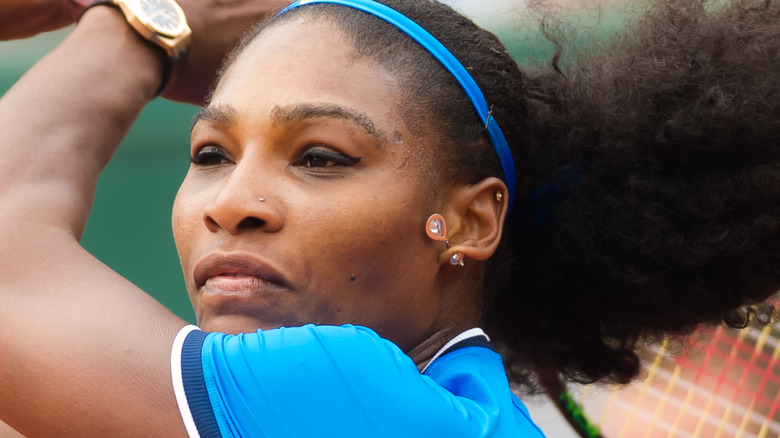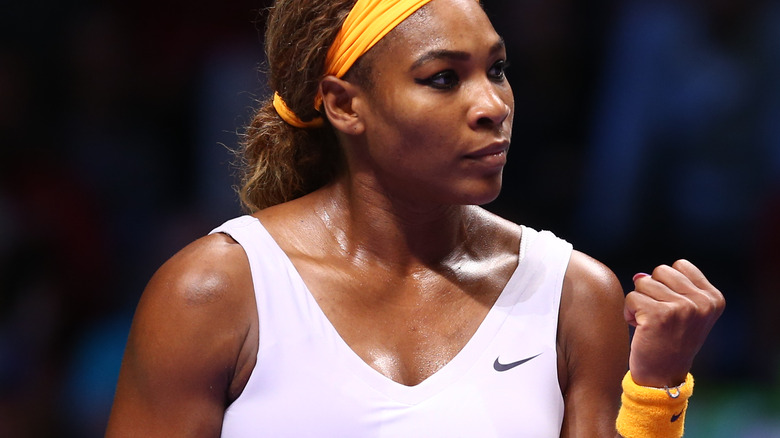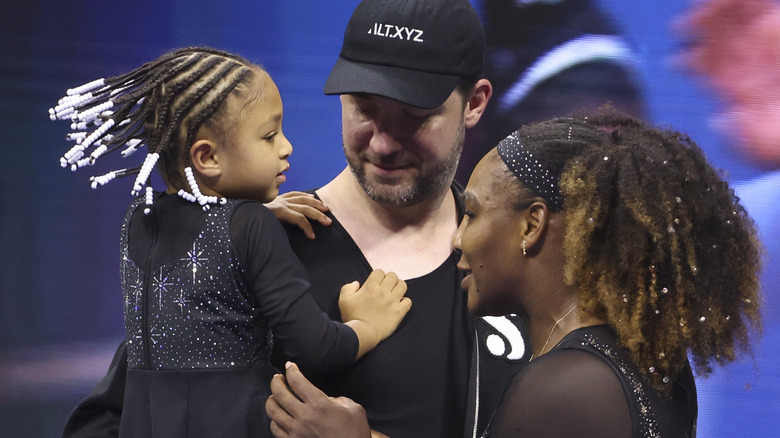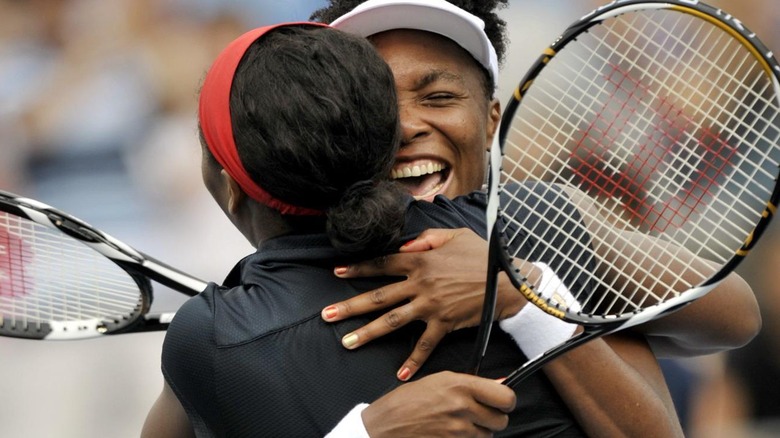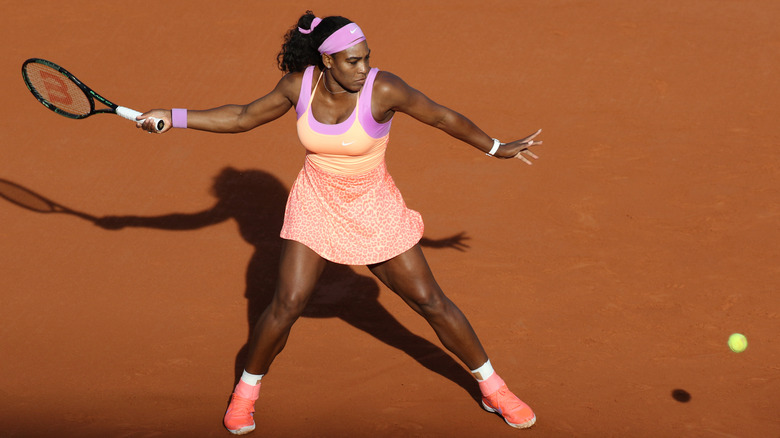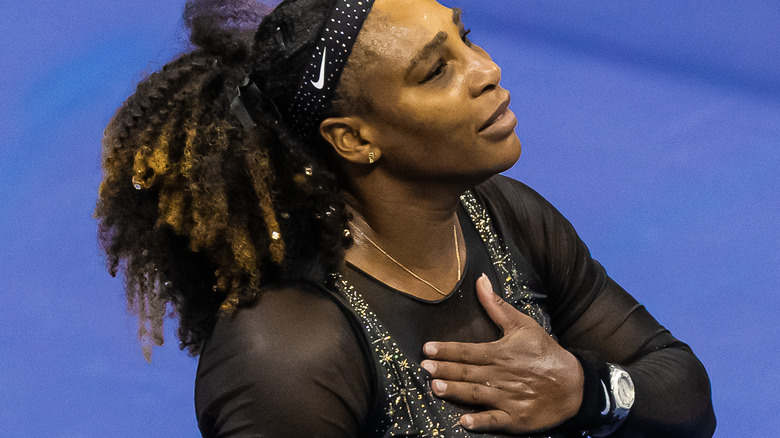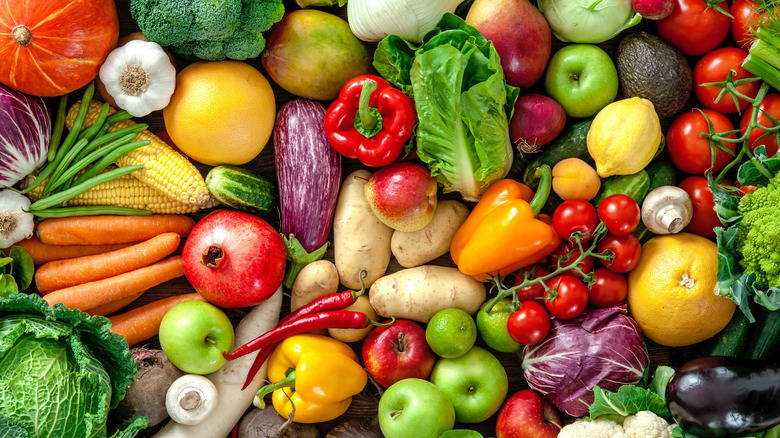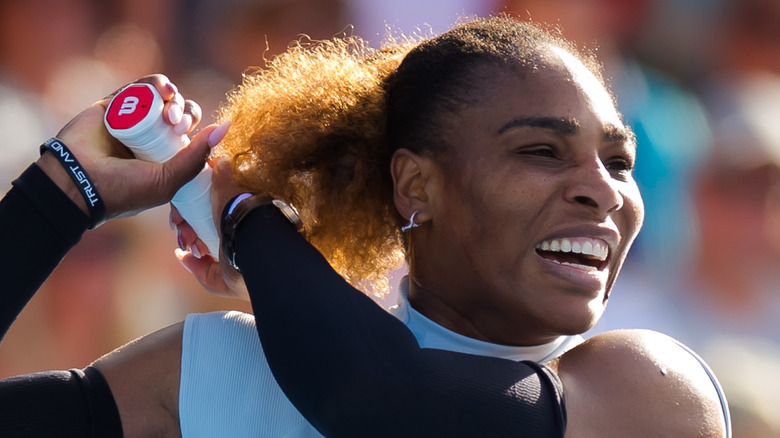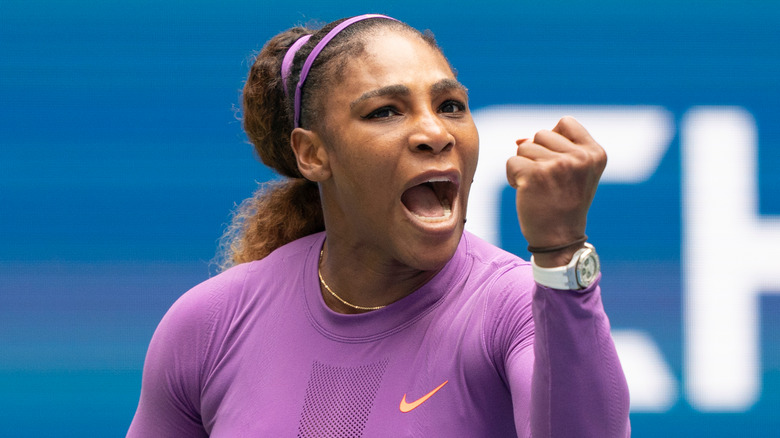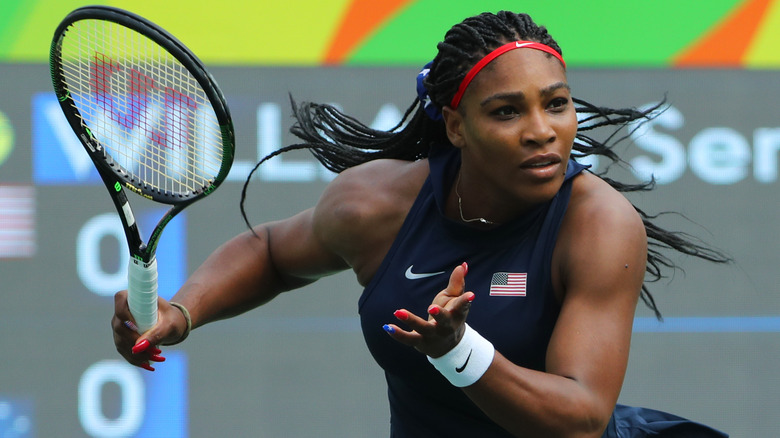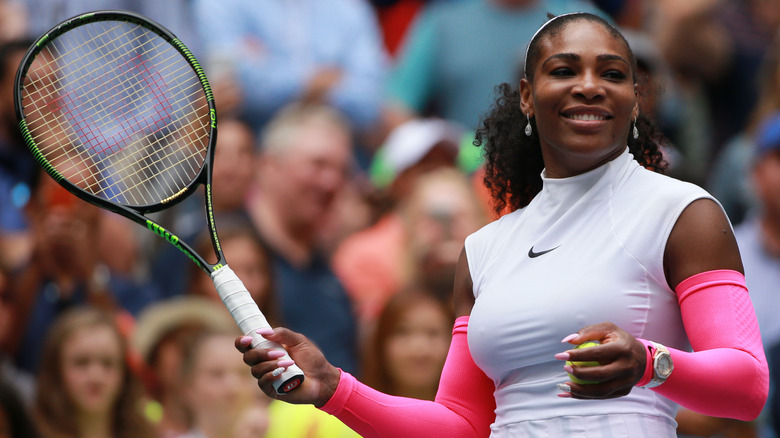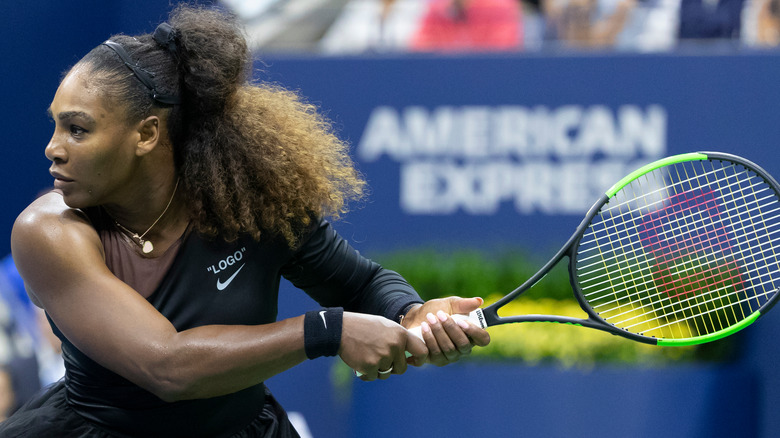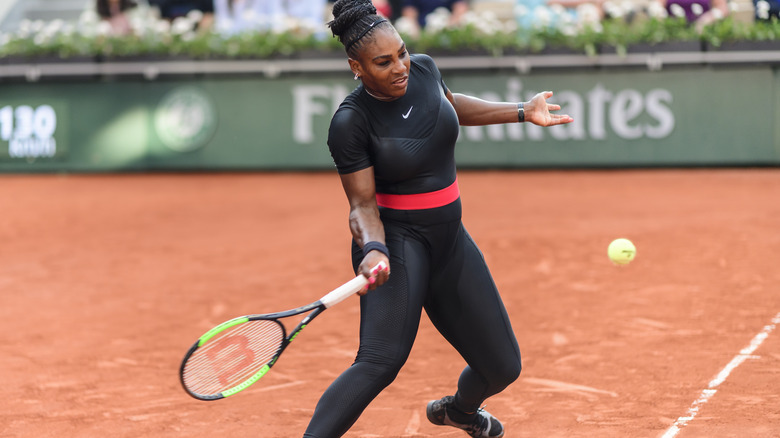The Diet And Fitness Routine That Fueled Serena Williams' Career
Not many people are bestowed with G.O.A.T. status, but Serena Williams certainly deserves it. Truly the "greatest of all time" in the world of tennis, Williams has won a total of 23 Gram Slam singles throughout her career — more than anyone else in the open era (via Britannica). The unparalleled tennis superstar is known for her sharp and lightning-like serve; watching her move on the tennis court is exceptionally mesmerizing.
Williams started her professional tennis career at age 14, after her dad trained her and her sister, Venus, on the courts of Compton, California (via ESPN). According to their father, Williams first picked up a tennis racket when she was only 3 years old. Together, Venus and Serena have won 14 major doubles titles and 3 Olympic gold medals, with Serena racking up 858 tour victories, 73 singles titles, and 1 Olympic gold medal on her own. Williams also spent 319 weeks in the number 1 spot.
In August 2022, at age 40, Williams announced her retirement from the sport. In an interview with VOGUE, she admits it was a bittersweet decision. "I'm torn: I don't want it to be over, but at the same time I'm ready for what's next," says Williams. "This sport has given me so much."
Serena Williams' retirement
"I have never liked the word retirement," says Williams in an interview with VOGUE. "Maybe the best word to describe what I'm up to is evolution. I'm here to tell you that I'm evolving away from tennis, toward other things that are important to me."
One of the main things fueling her "evolution" away from tennis is her family. Williams shares that she loves being there for her daughter, Olympia, who is now about 5 years old. She confirms that she and her husband, Alexis Ohanian, are planning on building their family. "Believe me, I never wanted to have to choose between tennis and a family. I don't think it's fair. If I were a guy... I'd be out there playing and winning while my wife was doing the physical labor of expanding our family."
However, Williams is quick to stress that she doesn't have any complaints about being a woman. Quite the opposite, in fact. "I loved every second of being pregnant with Olympia... A lot of people don't realize that I was two months pregnant when I won the Australian Open in 2017. But I'm turning 41 this month, and something's got to give," shares Williams.
Serena's plant-based diet
So how did Williams so seamlessly climb to the top? Besides her sheer determination, the tennis superstar's plant-based diet and training helped fuel her success.
It's no secret that Venus and Serena are close sisters. So when Venus went vegan after being diagnosed with Sjogren's syndrome, an autoimmune disease, Serena decided to join her in solidarity (via Eat This, Not That). By her own admission, Williams really looks up to her older sister. "I followed her around the world and watched her. When she lost, I understood why, and I made sure I wouldn't lose the same way. That's how I started to move so fast up the rankings, because I learned the lessons from Venus's losses instead of the hard way, from my own... But if I hadn't been in Venus's shadow, I would never be who I am," Williams told VOGUE.
As a matter of fact, the whole Williams family switched to a plant-based diet after Venus's diagnosis — Venus jokingly calls them "chegans" — because they eat mostly vegan, but "cheat" sometimes (via Women's Health Magazine). Williams says that the switch was pretty easy, because her food philosophy is to eat to live, not live to eat. She strives to live a healthy lifestyle and enjoys eating lots of greens and a mostly plant-based diet (via Women's Health Magazine).
Breakfast, lunch, and dinner
While some people say breakfast is the most important meal of the day, that cliche doesn't hold up for Williams. Sometimes, she skips breakfast if she's not feeling hungry or is too busy with Olympia.
When she does eat breakfast, it's typically oatmeal with fruit like strawberries or tangerines and some almond butter for protein (via Healthista). While she usually eats plant-based, she does sometimes have eggs in the morning (via Women's Health Magazine). Lunch is typically greens and protein, like a light salad with veggies and almonds, or a bean burger or gluten-free bean burrito. Dinner fluctuates depending on what she and her family are in the mood for, but it usually consists of brown rice, hemp or chia seeds, veggies, and maybe a salad. On occasion, they like to revel in "Taco Tuesdays."
Eating plant-based means that her diet is filled with lots of nuts, beans, lentils, and sprouted quinoa to help fill her protein needs. She confessed to Bon Appetit that her refrigerator "is really just vegan: coconut water, Gatorade (my favorite!), cucumbers, mint, kale, vegetables, ginger, and wheat grass."
Pre-game foods
While her regular diet consists mostly of leafy greens, what Williams eats before a match is a different story.
Williams participates in the classic carb-loading meal before a big game, usually eating rice or pasta the night before. "The only time I eat pasta is when I'm playing/training. Usually, you'll never see me eating pasta otherwise. 'Cause I feel like I've had to eat it so much in my career. It's just like, I never want to see pasta again," she told Women's Health Magazine with a laugh.
That said, you won't catch Williams eating a pasta-only bowl before playing. She likes to hit all the major food groups with her pre-game meal, balancing out her plate with greens, protein, and a little fruit on the side. She gets tired of eating the same thing every day, so she likes to keep things fresh by switching it up. "I can have a smoothie for six months, and then I'll be like, I never want to see a smoothie again for the next six months," she says.
Snacks and cheat meals
While Williams admits to Women's Health Magazine that she loves snacking, she tries to stay disciplined and keep it to a minimum when training. She likes to stick to healthy snacks, like sprouted bread or fat burning drinks with lemon juice, matcha green tea, or cinnamon (via Healthista).
But keeping true to the "chegan" identity, she enjoys cheating every now and then. The Williams family's signature dish is chicken and gravy with rice (via Bon Appetit). One of Serena's favorite dishes to cook is her roasted chicken recipe, with butter, garlic, onion, salt and pepper. She also really enjoys cooking gumbo and a dish she calls "seven-bean delight," which actually only has five beans. Ssssh.
Some of Williams' sweet treat cheats include molten lava chocolate cake and moon pies. Sometimes, she likes to splurge on fried chicken and grits, as well as pizza. The key for her cheating is to indulge, but without overdoing it. According to Williams, she never loses sight of her fitness and training goals (via Eat This, Not That).
Healthy pregnancy cravings
At the beginning of her pregnancy, Williams didn't experience a lot of stereotypical food cravings. Many women crave unhealthy foods like sweets, ice cream, and salty snacks like potato chips; some also feel the urge to snack on odd things like fish, pickles, yogurt, cheese, or milk (via On Health). But not Williams. In fact, when she finally starting experiencing food cravings, it was for vegetables.
Her husband, Alexis, shared in an Instagram post that he was the grocery store late one Friday night to pick up some of his wife's pregnancy food requests, which were zucchini, asparagus, and artichoke. Some chalked up these healthy cravings to the fact that Williams maintained a healthy lifestyle and plant-based diet for many years before her pregnancy (via Healthista).
Sustaining her mostly plant-based diet during pregnancy may have been one of the reasons Williams was able to get right back on the court after giving birth. She went to play Wimbledon only 10 months after Olympia was born (via The Guardian).
Strength training
Of course, diet is only one part of Williams' success. The star has undergone massive training and workout regimes for many years.
Williams emphasizes that it's not just physical strength that got her where she is today. "It's all about being your strongest in your mind and being able to conquer anything that you set your mind to. Mental strength, that's the strongest asset you have now," she said in an interview with Tonal. Physical strength training wasn't really a big part of Serena's life early in her tennis career. While she once avoided weight training, her workout routine quickly centered on tennis specific exercises, as well as strength building.
Williams views strength training as essential both for her success and in avoiding injury. Any time Williams sustained an injury in the past, her physical therapy incorporated exercises that helped to strengthen the muscles around the injured area. While not her favorite types of exercise — she found them to be boring — they have been key to her being able to play tennis as long as she has.
Serena's workout routine
Serena follows a full-body workout routine, crafted by her long-time trainer, Mackie Shilstone. She makes sure to focus a little bit on each body part, including arms, core, legs, and of course, the glutes.
Before jumping into her workout, Williams always begins with a set of warm-up exercises to help prep her body for the vigorous moves. Her warm-up routine usually involves some type of cardio for 10 minutes, with her top choice being zumba (via Workout Info Guru). She then moves into arm exercises, which involves doing a fitness ball transfer, rolling knee tucks, resistance band hip extensions, and plank rows, each for at least 3-4 minutes. Those are followed by her glute exercises, which includes barbell pause squats, barbell front squats, and barbell box squat, with 3-5 sets each. Next up are leg exercises, with a cycle of bicycle crunches, leg crunches (first horizontal then vertical), pillar holds, dumbbell walking lunges, and dumbbell step ups, doing 3-5 sets each.
Serena's ab routine
Serena's ab routine is quite detailed, which isn't that surprising (via Workout Info Guru). After all, a strong core requires determination and lots of work.
Planks are a great place to start for anyone trying to build up their core strength. Williams would practice side plank cable rows, in which you transition from a plank into a side plank, with one forearm resting on the ground (via Muscle and Fitness). The other arm would pull on a cable attached to a machine (but you could also use a band attached to something solid). 3 sets of 15 reps each should do the trick.
Then, she would move on to core work using a medicine ball (via Workout Info Guru). First, practicing medicine ball squats with a weighted ball, swinging it side to side, from her body towards her ear while squatting — practicing 3 sets of 15 reps each. Next up is side planks on the medicine ball: resting on top of the ball on her hip in the side plank position, then moving her hips up and down continuously 15 times, for a total of 3 sets. Then she would finish up with sprints (as if all that previous exercise wasn't enough).
Switching it up
In addition to her regular workout routine, Williams also does specific training for tennis. She doesn't want to sprint straight every day, though. "This sport is all about speed and changing direction because you have to do both all the time," says Williams' coach, Patrick Mouratoglou. For example, he would have her sprint then change direction quickly, going right or left depending on what signal he gave her, at different time intervals, so that she wouldn't be able to anticipate what would come next (via Refinery 29).
Just like how she doesn't like to drink smoothies every day for too long, she also doesn't like to stick to the same workout routine. "For me, it's so important to mix it up," Williams says. "I ran, and then I biked. Then I did elliptical. That didn't work out so well, because it was boring, so I tried yoga." When she was injured, her trainer improvised and suggested swimming, which was challenging but helpful. And when she was sick, she would dance for cardio.
Working out while pregnant
Williams did not take a major break from working out while she was pregnant. While the tennis champ's pregnancy workout routine was not as strenuous or intense as it was before she had a bun in the oven, she could be found at the gym doing squats with her baby bump.
The tennis star's goal was to exercise while pregnant as long as possible, not only to up her chances of having a healthy pregnancy and baby, but also to support her speedy recovery after childbirth. While Williams was overjoyed to be pregnant and have a daughter, she was also plotting her return back to her tennis career — and a little anxious about the health repercussions childbirth might bring. Williams admitted to having a lot of worries about the pregnancy, since being hospitalized in 2011 for bilateral pulmonary embolisms after a foot surgery meant her risk of blood clots had increased while being pregnant (via Healthy Celeb).
Serena's compression gear
Unfortunately, Williams' fears of blood clots came true. After giving birth, the tennis superstar was hospitalized and had to undergo several surgeries, ultimately calling it a near-death experience.
After childbirth, Williams knew that something was wrong when she started feeling pain and loosing feeling in her legs, but the doctors originally brushed it off. She had to insist for the tests that confirmed she had blood clots in her legs. "Being heard and appropriately treated was the difference between life or death for me. In the U.S., black women are nearly three times more likely to die during or after childbirth than their white counterparts. Many of these deaths are considered by experts to be preventable," Williams told USA Today.
When Williams returned to the court, her new fitness outfit included a catsuit and compression socks, which was critiqued by some as inappropriate tennis attire. However, Williams was wearing them to help increase blood circulation and decrease the chances of more blood clots developing. According to physical therapist Melissa Abellanida, "Serena Williams was using the catsuit as a medical device (via Texas Medical Center)." Besides, Williams was never one to be a conformist, anyway.

